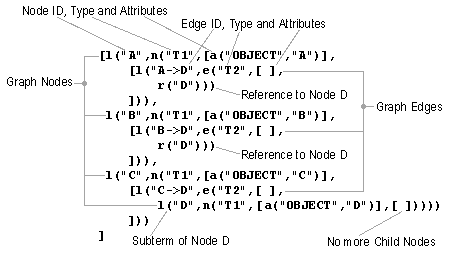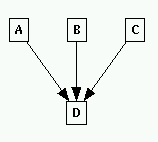
| Home |
| uDraw(Graph) |
| Download |
| Service & Support |
| Legal |
Syntax of the Term Representation
In general, a term is a structure where a superterm (parent) encloses its subterms (children), e.g. parent[child1,child2,child3]. Brackets "[...]" are used for a list of comma-separated elements of the same type. This scheme of expressing parent-child relationships can be applied recursively, so each child may have its own children, and so on. This notation allows to represent arbitrary tree structures.
To specify graphs, a mechanism of identifiers and references is used in uDraw(Graph). For example, if a child node has more than one parent node, then in the term representation the corresponding subgraph of the child appears in only one of the parents as a subterm. This subterm is marked with an identifier (in fact, all nodes and edges have to be marked with a unique identifier). All the other parents of the same child do not duplicate the subterm. Instead, they point to the child by using a reference to the identifier. Note that this way it is even possible to describe cyclic graphs. When loading a term representation, the system constructs an internal graph by resolving these references. The linear order of a node's subterm (where the identifier is declared) and a reference to this node (where the identifier is used) is arbitrary in a term representation, so references can be used before the corresponding identifier and subterm appears in the term representation.
Note:
You have to make sure that each node and edge in a term
representation has its own unique identifier, i.e. do not use the
same ID for two objects.
In
Beside the identifier (a unique string) and the list of child nodes
(which is probably empty), each node also has a type and a list of
attributes which are responsible for the image of a node in the
visualization.
For the exact

A term representation of a graph

The corresponding graph visualization